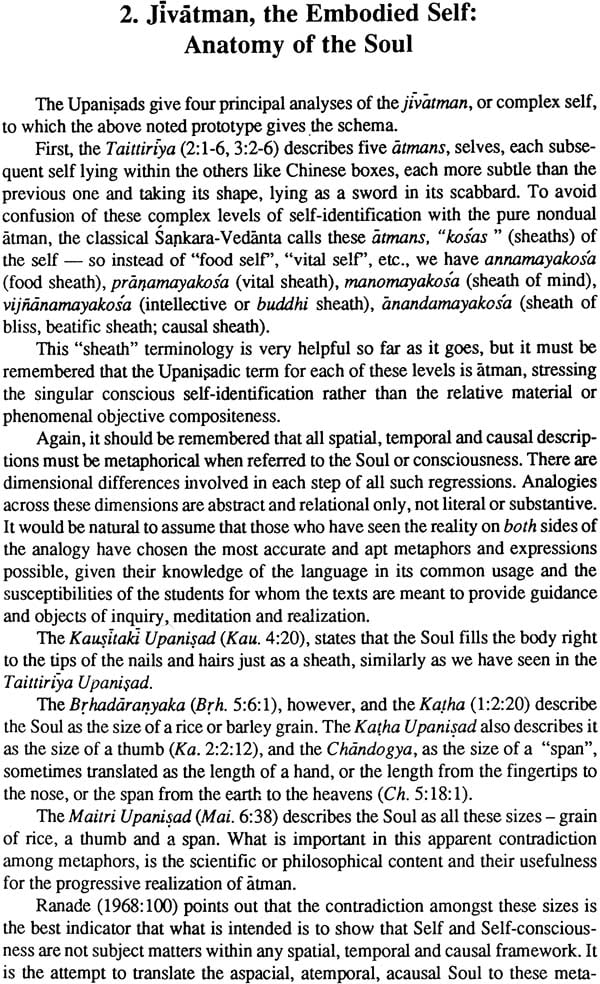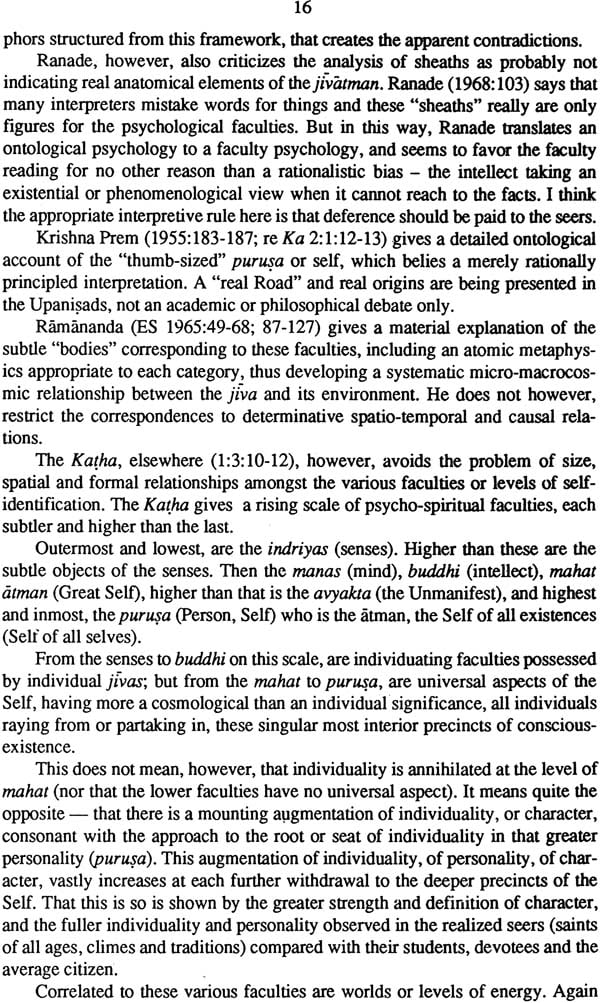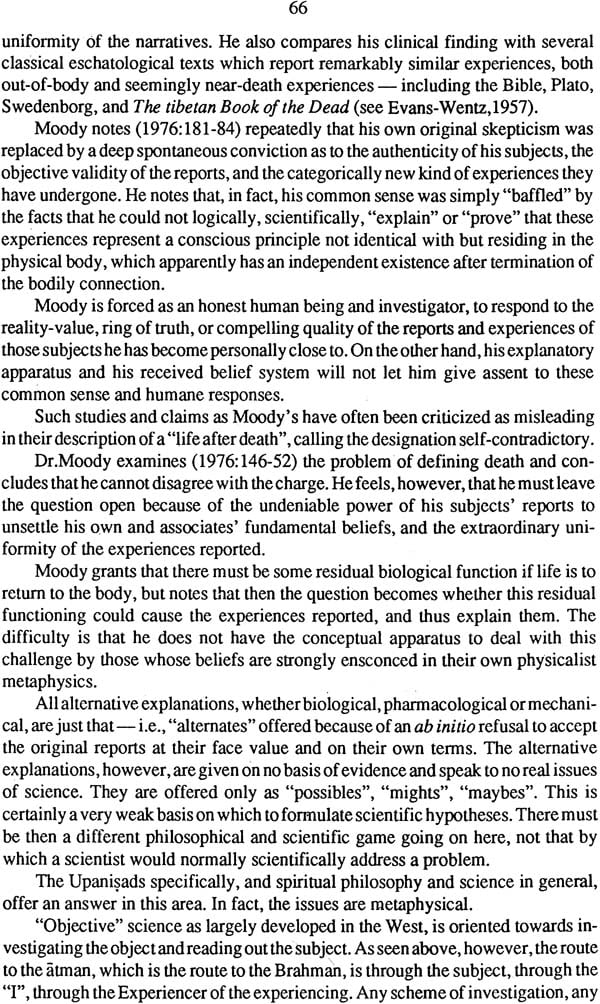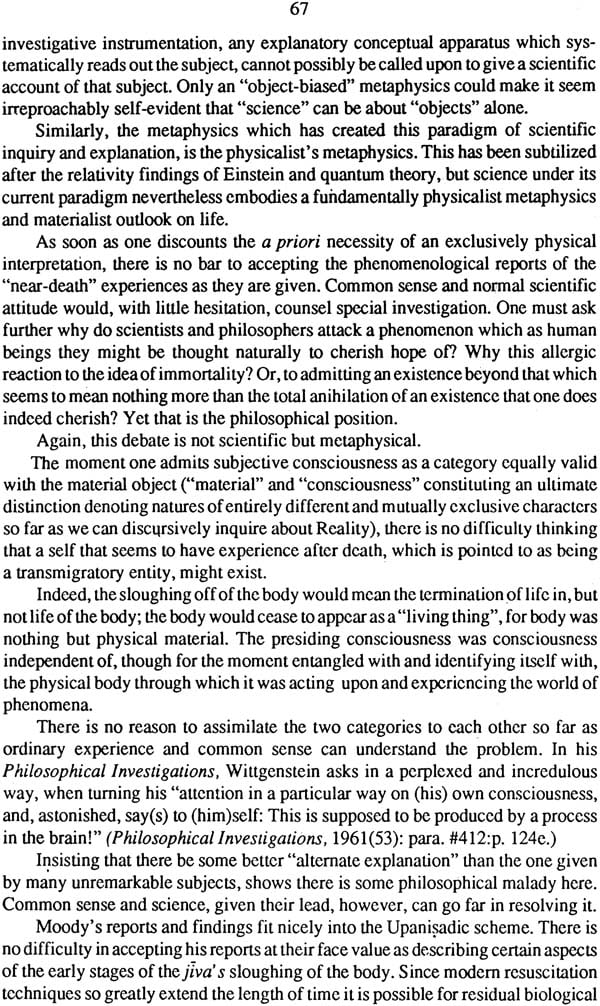
The Other Side of Death: Upanisadic Eschatology
Book Specification
| Item Code: | IHL297 |
| Author: | William A. Borman |
| Publisher: | Sri Satguru Publications |
| Language: | English |
| Edition: | 1990 |
| ISBN: | 8170302332 |
| Pages: | 84 |
| Cover: | Hardcover |
| Other Details | 8.9 Inch X 5.8 Inch |
| Weight | 210 gm |
Book Description
In his original study on the other side of death: Upanisadic Eschatology Dr. Borman brings the standards of science and philosophy to the interpretation of these often romanticized texts. He argues that while other classical thanatological texts do amp wide range of after death courses only the Upanisads give a systematic interpretation of the principle after death path as so many natural routes to the realization of our own native immortality. In support of this contention Dr. Borman presents an entirely new analysis of the anatomy of the jiva and its evolutionary relationship to Brahman (God) and provides fresh interpretations of the pedagogy and metaphorical language of the Upanishads. Further he clearly demonstrates their symbolical construction and meditative intent of these texts. Finally Dr. Borman explore his analysis in light of the evolutionary spiritualism of Swami Ramananda and the near death investigations of Dr. Raymond Moody and in conclusion show how these might aid in contemporizing Upanisadic studies placing them on a surer philosophical and scientific footing.
Dr. William A. Borman was born in 1948 in New York city received his B.A. in philosophy in 1973 from state University of New York at Purchase and his M.A. (1976) and Ph. D in philosophy from city University of New York in 1982 Dr. Borman’s critical study on Gandhi’s concept and methods of non violence Gandhi and Non-violence was published by state University of New York Press in 1986. This Study drew heavily upon his studies in Indic philosophy and Sanskrit undertaken in undergraduate and graduate schools and further under the guidance of Kumar Maharaj. Dr. Borman has also written several articles on topics in death and dying from a spiritual standpoint new being published by the foundation of Thanatolgy Columbia University Dr. Borman presently teaches philosophy at La Guardia Community college of the city University of New York and New York program exploring the application of philosophy to contemporary urban life on radio WBAI New York his wife Dr. Suzanne Borman teaches education at United states International University.
The Upanisads comprise the final portion of the Vedic literature of ancient India. The first three portions present the ritual means by which one might righteously win progeny, Wealth enjoyment and virtue in this world and the next. When one has enjoyed the results of his conduct and actions he returns to this life Samsara the round of birth, desire, enjoyment death rebirth.
In this round of life led by desire however suffering seems an inseparable component part. In life in which nothing comes to be which does not pass away there is at least the inevitable suffering which comes from the cessation of a cherished enjoyment. One may ask if their is any happiness which does not bring suffering and pain it its wake. Or one may ask from where does all this world of enjoyment and suffering arise? What sustains it where does it all lead?
The Upanisads record the most sustained efforts of science and philosophy to answer these questions not by speculation and debate but by direct experience and reason. The earlier portions of the Vedas elaborate the ancient or eternal religion out of which modern Hinduism arises. The Upanisads give the spiritual the philosophical and scientific kemel.
Where does it all lead? The Upanisads find that behind all phenomena within all phenomenon the substance of all phenomenon is a nondual noumena reality which they name Brahman. This Brahman is a massive unity. It is the same Ultimate reality equally within the objects. The Upanisadic seers find Brahman to be also the atman the Ultimate subject who is the seer of all seings the one who does the hearing whose thoughts these are. This atman is consciousness one nondual the same one enjoyer the one soul shinning out of all and each.
The most fundamental discovery and teaching of the Upanisads is the identity of Brahman and atman. The one transcendental reality transcendent of all object and all subject is that same atma Brahman. He is approached through the subjective “I” the Upanisads elaborate the science of following back consciousness through the subject-I to atman who is Brahma who has become all this!
For the Upanisadic seer the entire phenomenal existence the whole of life the rounds of joy and suffering birth and death become only symbols or figures for that Brahman who comprehends it all. The Upanisads redescribe all the facets of life death and the various paths between life and death – the heavens the hells the mid-regions the various courses of re-birth the paths above all these back to that immortal one and one’s own absorption into that one and attainment of that own’s immortality in the Upanisads through the identify relation of microcosm and macrocosm and the concept and practice of upasara these paths all become a mirror of and the means to that realization and consummation.
This study traces in detail all of these life and death courses as well as the course to immortality. For the Upanisads all these courses all object and subject all phenomenal and subjective reality are subordinate to that self knowing unity of atma Brahman but pre eminently useful in its realization. This study explores therefore how the Upanisads find the ultimate aim and meaning of life in the relation of these life and death courses to that Brahmanic reality. This meaning and aim is not a datum or symbolic understanding about reality but an experience of one’s self reality. This self reality is said to be of the nature of immortal bliss which is a self-fulfilling beyond whatever before gave rise to any question or need of meaning or aim.
The Egyptian book of the Dead and the Tibetan book of the Dead give great detail about the paths and worlds after death but they provide little about rebirth and immortality. The Upanisads elaborate the widest most complete and catholic picture of life and death and their ultimate meaning. The present study therefore suggests that the fullest and most complete picture of these phenomena and ultimate meaning may be given by a synthetic study of the various manuals on dying and the current phenomenological and scientific studies on the near death experience (Dr. Raymond Moody) and reincarnation (Dr. Stevenson) all in light of the foundational research presented in the Upanisads.
Finally the Upanisadic studies are discussed in relation to the evolutionary spiritualism of Ramananda and the near death studies of Professor Raymond Moody. The works of Ramananda and Moody have largely suggested the aims of this study and have deeply influenced its critical analysis.
Of special note in this study are the first full scale philosophical study both analytical and critical concentrating on the eschatology of the Upanisads vis-à-vis Advaita Vedanta etc the first sustained analytic discussion of the nature of the jiva the transmigrating soul insisting on the criteria of reason and science development of the microcosm macrocosm relation which is central to both the content and the pedagogies of the Upanisads adumbration of the concept of spiritual evolution as more fundamental than even the moral or ethical basis of Upanisadic eschatology and its controlling doctrines of karma and reincarnation elaboration of the supermoralism implied by this and critical analysis of the figure of Brahaman as lord n relation to the moral and spiritual efforts and evolution of the jiva. These points constitute an attempt to uncover the spiritual realism the author believes lies at the foundation of Upanisadic experience philosophy and science.
The reader should bear in mind the symbolic dimension of the Upanisadic and throughout the study recall its fundamental finding that all Upanisadic thought is ultimately figurative and metaphorical gesturing towards a reality beyond the reach of all words and subtending all the realities capable of being spoken about.
The following study draws on all the principle Upanisads and several of the chief philosophical interpreters of this century. For the most part texts are not quoted but paraphrased in the body of the discussion I have gone to the original Sanskrit for a good part of this study but cannot be considered an Indologist and Sanskritist for such a study a new and original translation would be required as the basis. My training is in philosophy and there I bring an original element to the discussions.
I have endeavored to be thorough in my references but in my instances I have chosen only several or two or only one representative citation illustrative of the philosophical point I am trying to make. This is in some cases for economy but in most cases I mean to stress specific items or a specific range of variation most appropriate to elucidate the philosophical content. It is the elaboration of this content that I wish to keep foremost rather than scholarly comprehensiveness for its own sake which might unfortunately obscure the main philosophical point.
I would like to express my tremendous gratitude for the translations and commentaries. I have freely drawn from in my paraphrasing or quoted in this study. In particular I am deeply indebted to Surama Dasgupta’s Development of moral philosophy in India Sri Aurobindo’s the Upanishads Swami Nikhilananda’s extensive translation of the Upanishads with the commentaries of Sankaracarya in four volumes Krishna Prem’s the Yoga of the kathopanishad P.T. Raju’s structural Depths of Indian though and R.D. Ranade’s a constructive survey of Upanishadic philosophy.
Excerpts form the introduction and the sections on Ramananda and Moody were published by the Charles press, Philadelphia penn in their collection perspectives on death and dying cross cultural and multi disciplinary views. I thank them for their immediate and generous permission to include these excerpts in this edition. Please not that the original manuscript was written for the foundation of thantology Columbia University so although this has been somewhat revised for this Sri Satguru Publications editions the text retains the orientation and style appropriate to that professional audience.
I am grateful also to Indian books centre for including this work in their series studies in Indian tradition on the recommendation of its editor Dr. Purusottam Bilimoria.
The invocation sums up the purpose and the substance of the Upanisads.
The Unreal Darkness and death denote the transient the ephemeral universe. The real light and immortality denote the changeless reality and the infinite the eternal the transcendental reality beyond and embracing both the being and the becoming which are really only its two aspects.
The purpose of the Upanisads is to lead one form the transient and the ephemeral whose nature is desire action and suffering to the changeless the one without a second the eternal whose nature is infinite peace and bliss.
The former is called samsara. The latter is called Brahman between samsara the phenomenal universe and Brahman the noumenal existence atman is as it were, a bridge, identifying itself with phenomena that reality knows itself as it acts as if it were one self among many identifying itself with Brahman it knows itself as the one self of all subjects.
The Upanisadic search into ultimate reality finds it to be nondual one without a second. There is a massive unity behind pervading and constituting all the infinite multiplicity Brahman is the substratum out of which all the universes and their inhabitants evolve by which they are sustained and into which they are withdraw at the end of each cosmic evolutionary cycle.
The aim of the Upanisads is to demonstrate the identity of atman with Brahman and to show the means by which the votary of understanding may realize this identity directly deep within himself.
The votary who wishes such understanding and realization ordinarily does no finding himself in a condition of pointless activity dreamlike meaningless unreal a condition of ignorance and obscurity darkness and numbness. He is nagged by a deep dread believing that death is the only definite result of all the ceaseless meaningless beating proliferating phenomenal whirl that confronts him. The Upanisads address the student so distressed and attempt to answer his invocation.
The human condition of self identification with phenomenal transiency implies such an existential characterizations of reality the root of this existential outlook is the dread of death that is naturally created by one’s self idenfication with all that one knows cannot but pass into nonexistence. The path from death to immortality may be taken as the chief subject of the Upanisadic teaching.
The present study will examine the Upanisadic solution to his problematic existential condition by inquiry into Upanisadic eschatology the other side of death.
| Preface | IX | |
| Abbreviations | XIII | |
| 1 | Introduction | 1 |
| The Upanisadic texts: Background and overview - Microcosmic Macrocosmic Identity The many faceted Unity of existence | ||
| 2 | Jivatman the Embodied self: Anatomy of the soul | 8 |
| 3 | Death and Eschatology Immortality and Transmigration - The time of Death Portents Cremation and Prana etc | 20 |
| 4 | Paths after Death | 21 |
| - Jivanmukti | 26 | |
| - Kramamukti | 26 | |
| - The Heavens | 30 | |
| - World of the Manes | 32 | |
| - Hells | 35 | |
| 5 | The Jivatman in Evolution | 36 |
| - Jiva the Enjoyer Jiva | 38 | |
| the Pilgrim | 38 | |
| 6 | Direction of the Transmigration | 47 |
| - Desire | 47 | |
| - Spiritual Evolution | 48 | |
| 7 | Lordship of Brahman | 52 |
| 8 | Supermoralism of the Upanisads | 54 |
| 9 | Upasana | 58 |
| 10 | New Eschatological investigations and concluding remarks | 61 |
| - Sri Ramananda | 61 | |
| - Dr. Raymond Moody | 64 | |
| References | 71 | |
| Recommended | 73 |









